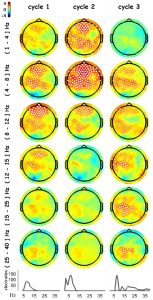Improve Fibromyalgia Symptoms with Mindfulness
By John M. de Castro, Ph.D.
“Mindfulness training is a low-cost, side-effect-free addition to fibromyalgia treatment that almost anyone can try — research suggests it helps you improve negative emotions surrounding fibromyalgia pain and, over time, change the way you respond to and think about your fibromyalgia symptoms.” – Madeline Vann
Fibromyalgia is a mysterious disorder whose causes are unknown. It is very common affecting over 5 million people in the U.S., about 2% of the population with about 7 times more women affected than men. It is characterized by widespread pain, abnormal pain processing, sleep disturbance, and fatigue that lead to psychological distress. Fibromyalgia may also have morning stiffness, tingling or numbness in hands and feet, headaches, including migraines, irritable bowel syndrome, sleep disturbances, thinking and memory problems, and painful menstrual periods. The symptoms are so severe and debilitating that about half the patients are unable to perform routine daily functions and about a third have to stop work. Although it is not itself fatal, suicide rates are higher in fibromyalgia sufferers.
There are no completely effective treatments for fibromyalgia. Symptoms are generally treated with pain relievers, antidepressant drugs and exercise. But these only reduce the severity of the symptoms and do not treat the disease directly. Mindfulness practices have also been shown to be effective in reducing pain from fibromyalgia. Some of the effects of mindfulness practices are to alter thought processes, changing what is thought about. In terms of pain, mindfulness training, by focusing attention on the present moment has been shown to reduce worry and catastrophizing. Pain is increased by worry about the pain and the expectation of greater pain in the future. The studies are accumulating, so, it would make sense to pause and summarize what has been learned.
In today’s Research News article “Mindfulness- and acceptance-based interventions for patients with fibromyalgia – A systematic review and meta-analyses.” (See summary below or view the full text of the study at: https://www.ncbi.nlm.nih.gov/pmc/articles/PMC6719827/), Haugmark and colleagues review, summarize, and perform a meta-analysis of the published randomized controlled trials exploring the effectiveness of mindfulness- and acceptance-based interventions in the treatment of fibromyalgia. They found 9 published randomized controlled trials employing Mindfulness-Based Stress Reduction (MBSR), Mindfulness-Based Cognitive Therapy (MBCT), or Acceptance and Commitment Therapy (ACT).
They found that the published research studies report that the mindfulness- and acceptance-based interventions produced small to moderate but significant improvements in the fibromyalgia patients’ levels of pain, depression, anxiety, sleep quality, health-related quality of life, and mindfulness. These benefits were sustained at follow-up but were diminished in magnitude. Hence, these interventions were safe and effective treatments for the suffering and psychological well-being of patients with fibromyalgia.
Mindfulness-Based Stress Reduction (MBSR), Mindfulness-Based Cognitive Therapy (MBCT), and Acceptance and Commitment Therapy (ACT) are quite different therapies with some vastly different therapeutic techniques. But they all have in common, mindfulness training. So, it would appear that mindfulness training was the critical component responsible for the benefits. This should not be surprising as mindfulness has been shown in many studies of various healthy and distressed groups to improve pain, depression, anxiety, sleep quality, and health-related quality of life. But fibromyalgia has no cure and causes great suffering in its victims. It is very comforting to see that mindfulness training can, at least, mitigate the suffering.
So, improve fibromyalgia symptoms with mindfulness.
“people with fibromyalgia may have what’s called an “attentional bias” toward negative information that appeared to be linked to pain severity. Researchers suggested that mindfulness training may help manage this trait and therefore reduce pain.” – Adrienne Dellwo
CMCS – Center for Mindfulness and Contemplative Studies
This and other Contemplative Studies posts are also available on Google+ https://plus.google.com/106784388191201299496/posts and on Twitter @MindfulResearch
Study Summary
Haugmark, T., Hagen, K. B., Smedslund, G., & Zangi, H. A. (2019). Mindfulness- and acceptance-based interventions for patients with fibromyalgia – A systematic review and meta-analyses. PloS one, 14(9), e0221897. doi:10.1371/journal.pone.0221897
Abstract
Objectives
To analyze health effects of mindfulness- and acceptance-based interventions, including mindfulness-based stress reduction (MBSR), mindfulness-based cognitive therapy (MBCT) and acceptance and commitment therapy (ACT). Additionally, we aimed to explore content and delivery components in terms of procedure, instructors, mode, length, fidelity and adherence in the included interventions.
Methods
We performed a systematic literature search in the databases MEDLINE, PsychINFO, CINAHL, EMBASE, Cochrane Central and AMED from 1990 to January 2019. We included randomized and quasi-randomized controlled trials analyzing health effects of mindfulness- and acceptance-based interventions for patients with fibromyalgia compared to no intervention, wait-list control, treatment as usual, or active interventions. MBSR combined with other treatments were included. Predefined outcomes were pain, fatigue, sleep quality, psychological distress, depression, anxiety, mindfulness, health-related quality of life and work ability. The Template for Intervention Description and Replication (TIDieR) checklist and guide was used to explore content and delivery components in the interventions. Meta-analyses were performed, and GRADE was used to assess the certainty in the evidence.
Results
The search identified 4430 records, of which nine original trials were included. The vast majority of the participants were women. The analyses showed small to moderate effects in favor of mindfulness- and acceptance-based interventions compared to controls in pain (SMD -0.46 [95% CI -0.75, -0.17]), depression (SMD -0.49 [95% CI -0.85, -0.12]), anxiety (SMD -0.37 [95% CI -0.71, -0.02]), mindfulness (SMD -0.40 [-0.69, -0.11]), sleep quality (SMD -0.33 [-0.70, 0.04]) and health-related quality of life (SMD -0.74 [95% CI -2.02, 0.54]) at end of treatment. The effects are uncertain due to individual study limitations, inconsistent results and imprecision.
Conclusion
Health effects of mindfulness- and acceptance-based interventions for patients with fibromyalgia are promising but uncertain. Future trials should consider investigating whether strategies to improve adherence and fidelity of mindfulness- and acceptance-based interventions can improve health outcomes.
https://www.ncbi.nlm.nih.gov/pmc/articles/PMC6719827/









